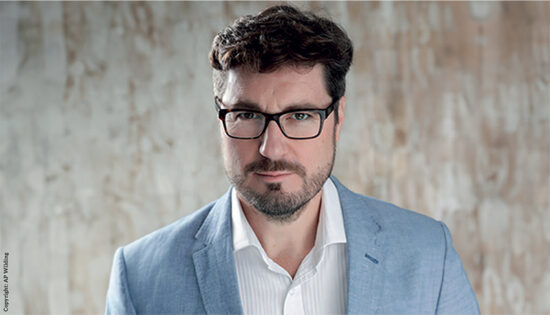What is your career background?
I joined Price Waterhouse [now PricewaterhouseCoopers] in Gothenburg, Sweden in 1990. Having worked for a few years in different departments and gained experience, I felt it was time to move on. So I joined Swedbank Insurance as CFO in the mid ’90s. At that time, bank assurance was a new concept in Sweden and this was a start-up, selling life assurance through the largest retail bank network on the Swedish market.
After a couple of years as an independent consultant, I ended up working for SEB Life Ireland as head of operations and finance. I was promoted to MD in 2005. Looking back, the timing could not have been better. After the financial crisis hit the Irish banks, we were able to purchase Irish Life International [ILI].
How would you describe your management style?
It was described for me a few years ago. Apparently, it’s called “soft on people, hard on issues”. I strongly believe in a workplace where people can come in without a tight knot in their stomachs. We are all different and we all need to be able to live our lives.
But on the other hand, things need to happen and they need to happen now. So speed, focus and delivery are just as important as flexible working hours and team building.
What is the hardest business lesson you have learned?
Business is business. That means you do what it takes, and sometimes what it takes is not very nice. Good business is not only about generating more revenues. Costs and risks need to be managed as well, and that is not as glamorous.
SEB completed its acquisition of Irish Life International at the end of August 2011. What were the main reasons behind the purchase?
The first is that it fits within the strategy for the SEB Life division. The division is expected to develop and grow. We work with organic growth all the time, but when there is an opportunity to acquire a business that fits with what you do, I think you should take it.
Another important reason behind the purchase is that SEB Life Ireland has successfully written single premium life business across one territory – Sweden – for many years.
That can be risky, because the business is tax-driven and tax laws are constantly subject to change.
SEB Life Ireland has managed to diversify somewhat since 2005, launching the occupational pension business in Sweden and re-entering the Finnish market. When the opportunity arose to acquire ILI, with its larger footprint in Europe, we took it.
Last is economy of scale. The increased focus on regulatory issues, compliance, risk management and Solvency II, significantly increases the overheads for life assurance operations. It costs more to run a life company, and to support the higher costs, the business needs to be bigger.
It was expected that Irish Life International would be rebranded SEB Life International within six months of the deal. Is this process on track?
Yes. When this is printed, ILI will have already been re-named SEB Life International. A dedicated team has worked on this project since August. About 800 brochures and documents in several different languages needed to be re-branded, including system output and the development of a new website.
Another separate project has been started in order to merge the two businesses. It is mainly a legal project involving, among other things, two high court decisions. Before the end of 2012, all business will be written by one company.
How have Irish Life International customers been affected by the acquisition of the company?
On a practical level nothing has changed, except for the ownership of the shares. Business is carried out as before, and ILI is, and was, a well-consolidated company. It will become clear to customers when we rename the company and change the corporate colour from blue to green.
On a sub-conscious level, one could argue that in the current climate, it might appear safer to have your policy with a Swedish-owned entity than an Irish-owned entity.
What are your long-term objectives for the combined business?
The first relates to markets and distribution, where the long-term objective is to grow. In order to do that we need more and diversified distribution. A lot has been done but, luckily for us, there is more to do.
Without going into detail, I would prefer to strengthen the distribution in our existing territories before entering new territories. Unfortunately it is a moving target and you could lose what you have, so it is not as simple as just getting more people to understand your product. You need to develop the product and the sales process, in order to keep what you have.
The second long-term objective is internal, but will have a bearing on the quality of what we do. We need to consolidate the functions internally and that will take time. We need to create common processes, one IT platform, the same look and feel in product documentation, and establish common key performance indicators among other things.
The third, but not least important, long-term objective is a little more difficult to measure. We need to develop a common corporate culture.
Where are your key target markets?
Sweden, Finland and Italy. Other markets with existing business and good potential would be the Netherlands, Belgium, France and Spain.
The question mark is mainland UK. Of course, we have a list of other potential markets, but I think it is too early to expand upon this now.
What are the biggest challenges and opportunities that the company faces?
The biggest opportunity is the combination of the two skill-sets. ILI has compliant products in nine countries and a vast knowledge of how the cross-border life business is conducted on the continent.
SEB Life Ireland has a strong foothold in the Nordic markets and a strong efficiency-oriented mindset. If we can combine these skill-sets successfully, we will do well.
The challenges are many. To navigate and succeed in a global and European financial environment with so much uncertainty is a challenge. Will the euro survive? What will happen to the common European market?
It appears that regulators in various countries are trying to make up for the failure of financial systems in 2008. More of a good thing is not always better, but that is a hard lesson to teach.
Solvency II is a challenge in itself, with its new risk-based methodology to calculate the capital requirements for a life company. The challenge is to try to understand and comply with rules at the same time as they are written.
More countries are investigating if commission to independent intermediaries should be banned. If commission is banned, how will intermediaries get paid, and how will we get our products on the market? Perhaps most important of all, who will give financial advice to customers and in what way will they get paid?
Apart from that we have the ordinary challenges of keeping up with trends, changes to rules and regulations, and new market conditions in nine countries.
In what ways do you expect the international life industry to change over the next five years?
We will see some consolidation of the business. A few mergers and maybe a few smaller players will decide that enough is enough.
We will continue to create compliant tax-efficient single premium investment products but these will continue to change, in order to reflect changes in tax rules. Markets will be closed and new markets will open as opportunities arise.
The question is whether the international life industry will seriously step into the pension business.
What are your likes and dislikes about the sector?
I like that I never get bored. It is complicated and I learn new things every day. The life assurance business is like a club that once you have joined, you never leave.
What I dislike is that the sector has been caught in the regulatory net which has arisen from the global banking crisis in 2008. Life assurance companies are not banks. We do not lend money and we do not take collateral.
We face different risks that need to be handled in different ways, compared with banks. But I feel we have been bundled together with the banks in this financial mess, and I am not entirely sure we deserve that.








